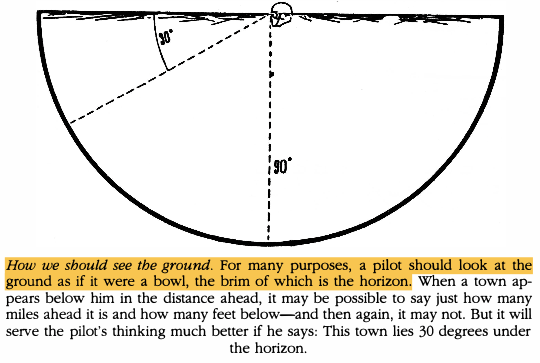
Book: Stick and Rudder: An Explanation of the Art of Flying
Author: Wolfgang Langewiesche
Genre: Aviation
Rating: ★★★★
REVIEW
“Stick and Rudder” digs into the nuts and bolts of flying not just the “how” but the “why” behind it. For example, Langewiesche explains how pilots don’t just see the ground in terms of flat distances or heights but rather through angles, angle from the horizon. This perspective completely changed how I understand Aim Point. Suddenly, it clicked why the Aim Point stays fixed in the picture as you come down. If you crave to understand the logic behind every manoeuvre, every work cycle, this book totally delivers.
Written back in the 40s, it has deffo stood the test of time when it comes to the basics of flying. But here’s my beef, the writing style. He doesn’t just tell you, he takes you on a journey. Heaps of analogies, detailed scenarios, and winding paths to get to the point. On one hand, it’s like a seasoned pilot passing on wisdom. On the other, it’s wordy, sometimes a bit of a slog. Sometimes i had to go back and re-read bits just to figure out what he was getting at. For example…..
Your kid brother thinks that an airplane turns because the rudder is held over; he thinks that an airplane’s rudder pedals do in the airplane exactly what the steering wheel does in an automobile. Almost every beginning student has the same idea; and even quite a few experienced pilots still will tell you the same, though they don’t actually fly that way. It’s still in many books — what’s worse, it is still being taught to kids in high schools! That idea is the worst single misconception about flying that is today still widespread. It is a curse. It causes more headache to student pilots than any other single thing in flying; almost every student wastes a lot of time because he can’t figure out what to do with the rudder and when and why. It also kills more pilots than any other cause, save perhaps that other idiocy, the idea that pulling the stick back makes the airplane go up. Or rather, it is the combination of the tum-by-rudder fallacy with the up-by-elevator fallacy that is sure poison.
“Common misconception is that the rudder turns the plane like a car’s steering wheel — wrong and dangerous. Same with thinking pulling the stick makes the plane go up. These mistakes waste time and cause crashes.” yay that’s what he trying to say above.
It’s like listening to your grandpa’s stories, you know there’s wisdom in there, but you have to work for it.
Still, quirks and all, a great read. If flying is your thing, this is a must-read. Just know you’ll have to power through some vintage prose along the way.
TAKEAWAYS & EXCERPTS
“Flying instinct” consists of: small clues, understood correctly and reacted to automatically.
CH 4: The Flying Instinct
Stick and Rudder: An Explanation of the Art of Flying by Wolfgang Langewiesche
Pilots are able to sense lift through
➊ Speed
➋ Sound (Still remember Chris my CFI asked me to recognise the engine sound at 1500 rpm and adjust the power by sound alone)
➌ Aileron feel
➍ AoA
➎ Hard or soft ride
➏ Stick pressure
➐ Stick position
If altitude is money in the bank, speed is money in the pocket
CH 5: The Law of the Roller Coaster
Stick and Rudder: An Explanation of the Art of Flying by Wolfgang Langewiesche
Wind is air in motion
CH 6: Wind Drift
Stick and Rudder: An Explanation of the Art of Flying by Wolfgang Langewiesche
Effects of wind hinge on 3 key idea
➊ Air is a thick, heavy fluid
➋ Relativity of motion, concept of “frame of reference”
➌ Motion through the air + motion with the air (drift)
Lateral stability is not about keeping wings level but about preventing sideslips and skids […] Longitudinal stability commonly misunderstood as maintaining speed, but fundamentally about maintaining a constant Angle of Attack.
CH 7: What the Airplane Wants to Do
Stick and Rudder: An Explanation of the Art of Flying by Wolfgang Langewiesche
Elevator is really the airplane’s speed control, the throttle is really its up-and-down control.
CH 9: The Flippers and the Throttle
Stick and Rudder: An Explanation of the Art of Flying by Wolfgang Langewiesche
Any change of stick position has usually two effects on the flight path
➊ A quick immediate effect (usually a ballooning when you pull the stick back)
➋ Then a steady long-run effect (sometimes a downward deflection of the flight path).
The important thing to understand about the rudder pedals is that they are unnecessary; like your wisdom teeth, they serve no very good purpose but can cause much trouble.
CH 11: The Rudder
Stick and Rudder: An Explanation of the Art of Flying by Wolfgang Langewiesche
Turning ability depends on 3 factors
➊ Speed
➋ Bank maintenance ability
➌ Quickness of rolling into bank
“Whether to use rudder at any given moment, and on which side, and how much?” There are two answers to this. […] Reasoning and “Seat of your pants”
CH 11: The Rudder
Stick and Rudder: An Explanation of the Art of Flying by Wolfgang Langewiesche
Both light and heavy wing-loaded aircraft follow the same physical laws, but the operational demands differ significantly. Light aircraft can be managed through trial and error, whereas heavy aircraft require pilots to anticipate and react with precision. Therefore, they must use more accurate judgement to begin with.
Straight flight consists of a series of S turns, the turns being shallowed out so much that the S finally becomes a straight line.
CH 13: Straight & Level Cruising
Stick and Rudder: An Explanation of the Art of Flying by Wolfgang Langewiesche
Remember to reverse corrections once they’ve done their job. Just because something looks right at the moment doesn’t mean the underlying factors are in proper balance eg. flying too low, correction: add power & nose up. when you get back to the right altitude, if you don’t undo your earlier correction (reduce power and lower the nose), you’ll end up too high.
In flying, knowing what not to do is often the more important part of wisdom.
CH 14: The Glide
Stick and Rudder: An Explanation of the Art of Flying by Wolfgang Langewiesche
The very great difference between simply being able to do the glide, the turn, and so forth, competently, and applying them to good advantage when it matters.
CH 14: The Glide
Stick and Rudder: An Explanation of the Art of Flying by Wolfgang Langewiesche
Perhaps the most important of all is the position of the intended landing spot “under” the horizon. The pilot starts his glide when the spot is in the “right” position relative to the horizon.
CH 15: The Approach
Stick and Rudder: An Explanation of the Art of Flying by Wolfgang Langewiesche
The pilot is interested mostly in the angle at which things lie under him rather than in absolute distances and heights.
CH 15: The Approach
Stick and Rudder: An Explanation of the Art of Flying by Wolfgang Langewiesche

The aim point does not move because as the pilot comes closer and loses altitude, the horizon comes down with him.
◃ Back
